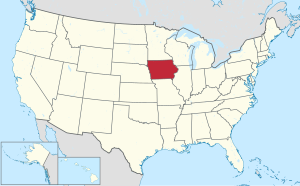Cedar County, Iowa
Cedar County | |
|---|---|
 Location within the U.S. state of Iowa | |
 Iowa's location within the U.S. | |
| Coordinates: 41°46′05″N 91°07′43″W / 41.768055555556°N 91.128611111111°W | |
| Country | |
| State | |
| Founded | 1837 |
| Seat | Tipton |
| Largest city | 582 square miles (1,507 km²). 580 square miles (1,501 km²) of it is land and 2 square miles (6 km²) of it (0.42% |
| Area | |
| • Total | 582 sq mi (1,507 km2) |
| • Land | 580 sq mi (1,502 km2) |
| • Water | 2 sq mi (6 km2) 0.42% |
| Population (2000) | |
| • Total | 18,187 |
| • Density | 31/sq mi (12/km2) |
| Time zone | UTC−6 (Central) |
| • Summer (DST) | UTC−5 (CDT) |
Cedar County is a county located in the U.S. state of Iowa. It is named for the Red Cedar River, which runs through the county, and is the only Iowa county which shares the name of a tree. As of 2000, the population is 18,187. Its county seat is Tipton.Template:GR
Geography
According to the U.S. Census Bureau, the county has a total area of 582 square miles (1,507 km²), of which, 580 square miles (1,501 km²) of it is land and 2 square miles (6 km²) of it (0.42%) is water.
Major highways
Adjacent counties
- Jones County (north)
- Clinton County (northeast)
- Scott County (southeast)
- Muscatine County (south)
- Johnson County (west)
- Linn County (northwest)
National protected area
History
Cedar County was formed on December 21, 1837 from sections of Dubuque County. It was named for the Red Cedar River.
Demographics

| Census | Pop. | Note | %± |
|---|---|---|---|
| 1900 | 19,371 | — | |
| 1910 | 17,765 | −8.3% | |
| 1920 | 17,560 | −1.2% | |
| 1930 | 16,760 | −4.6% | |
| 1940 | 16,884 | 0.7% | |
| 1950 | 16,910 | 0.2% | |
| 1960 | 17,791 | 5.2% | |
| 1970 | 17,655 | −0.8% | |
| 1980 | 18,635 | 5.6% | |
| 1990 | 17,381 | −6.7% | |
| 2000 | 18,187 | 4.6% | |
| IA Counties 1900-1990 | |||
As of the censusTemplate:GR of 2000, there were 18,187 people, 7,147 households, and 5,138 families residing in the county. The population density was 31 people per square mile (12/km²). There were 7,570 housing units at an average density of 13 per square mile (5/km²). The racial makeup of the county was 98.47% White, 0.19% Black or African American, 0.19% Native American, 0.30% Asian, 0.03% Pacific Islander, 0.26% from other races, and 0.57% from two or more races. 0.94% of the population were Hispanic or Latino of any race.
There were 7,147 households out of which 33.30% had children under the age of 18 living with them, 61.60% were married couples living together, 6.70% had a female householder with no husband present, and 28.10% were non-families. 23.70% of all households were made up of individuals and 11.90% had someone living alone who was 65 years of age or older. The average household size was 2.51 and the average family size was 2.96.
In the county the population was spread out with 25.30% under the age of 18, 6.90% from 18 to 24, 27.70% from 25 to 44, 23.80% from 45 to 64, and 16.20% who were 65 years of age or older. The median age was 39 years. For every 100 females there were 97.50 males. For every 100 females age 18 and over, there were 94.60 males.
The median income for a household in the county was $42,198, and the median income for a family was $48,850. Males had a median income of $32,008 versus $23,260 for females. The per capita income for the county was $19,200. About 4.00% of families and 5.50% of the population were below the poverty line, including 5.00% of those under age 18 and 7.70% of those age 65 or over.
Cities and towns
Cities
Other localities
Townships
Cedar County is divided into seventeen townships:
History
- Herbert Hoover, the 31st US president, was born in West Branch in 1874.
- John Brown maintained his headquarters at William Maxson's house near the small community of Springdale in Cedar County while planning his Harpers Ferry raid; Edwin and Barclay Coppock of Springdale participated in the raid.

